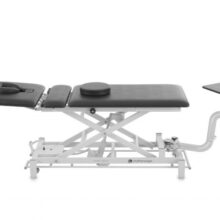Galaxy TTET300 Traction Table
Se connecter pour obtenir les prix des revendeurs
The Galaxy TTET300 traction table is designed to provide effective and efficient spinal traction treatment. For use by Healthcare Professionals only.
Traction therapy is a modality in which motorized mechanical force is applied to the spine in order to separate the vertebrae. It is a form of nonsurgical spinal decompression therapy that is aimed at relieving intradiscal pressure and easing back and neck pain.
Traction therapy can be applied to either the upper back area (cervical traction) or to the lower back (lumbar traction).
Spinal traction therapy has been used to treat vertebral disorders for almost 4000 years.
Today you can receive this type of therapy from physical therapists that have been trained in its application. It is also available from chiropractors as well as physicians who have received appropriate training.
Traction equipment is used to apply the forces used in traction therapy. This equipment usually consists of a traction motor unit, together with ropes and pulleys.
Equipment used for traction therapy falls into two broad categories:
As always, we advise you not to treat the contents of this article as professional medical advice. If you are considering undergoing traction therapy, whether at home or in a clinic, we suggest that you first discuss this decision with your primary medical advisor(s).
There are different types of traction therapy based on the nature of the force that stretches the spine.
In some cases, the traction is intermittent, i.e. it cycles between traction and relaxation using intervals that are a few minutes long.
Sustained traction involves a continuous and constant force that is maintained for between 20 and 60 minutes.
Finally, continuous traction involves a force that is maintained for several hours or even for days at a time.
Traction therapy can also be categorized according to the directions of the forces applied:
The goal of spinal traction therapy is to gently stretch the spine. Traction therapists hope that this stretching will reduce pressure between the discs of the spine.
If your back pain is caused by herniated discs, this negative pressure in the discs will reduce their herniation (bulging). This will in turn reduce pressure on the nerves adjacent to the spine (a cause of significant back pain).
Another positive result of the decreased pressure is greater ability of the body to provide water, oxygen and other restorative nutrients to damaged spinal discs.
Spinal decompression therapy may be used in conjunction with other modalities such as electrical muscle stimulation, ultrasound and hot/cold therapy. Your physical therapist will use his/her training and experience to decide on the combination of therapies best suited to treat your particular condition.
Spinal decompression therapy plays a key role in physical therapy used to treat a wide variety of back and spinal cord problems. These include:
Spinal traction is generally felt to be a safe procedure for treating pain in the neck or cervical spine area. However, its use may be contraindicated for certain individuals:
In addition to the above, individuals who are pregnant should exercise caution ( and seek medical advice) before embarking on a course of traction therapy. This also applies to individuals who have suffered from abdominal or other types of hernias or those who have experienced aortic aneurysms.

Se connecter pour obtenir les prix des revendeurs
The Galaxy TTET300 traction table is designed to provide effective and efficient spinal traction treatment. For use by Healthcare Professionals only.

Se connecter pour obtenir les prix des revendeurs
The Saunders traction unit offers a solution to those looking to use traction therapy to relieve TMJ compression at home.

Se connecter pour obtenir les prix des revendeurs
Chatttanooga’s TX traction motor unit offers 3 traction modes as well as the ability to set user defined hold, rest and treatment times. For use by Healthcare Professionals only.